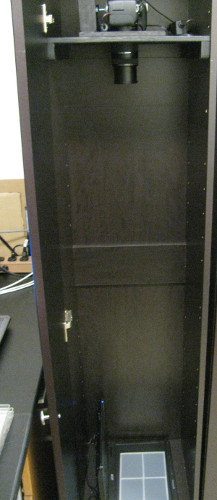Zebrafish Avoidance and Thigmotaxis Assay: A High-Throughput Method to Examine Larval Behavior in Response to Aversive Visual Stimulus
Abstract
Source: Richendrfer, H., et al. Automated High-throughput Behavioral Analyses in Zebrafish Larvae. J. Vis. Exp. (2013)
The video describes the avoidance and thigmotaxis assay of zebrafish larvae. The video examines the behavior of zebrafish larvae in response to visual aversive stimulus.
Protocol
1. Image Capture
- Up to 20 larvae can be placed in each lane of the plates. Typically 5 larvae per lane are used to facilitate the most accurate tracking of swim speed and to reduce the number of larvae that are needed per experiment. The lanes can be filled with egg water with or without pharmaceuticals or toxicants depending upon the experiment. However, lanes should not be filled up all the way until they are placed in the imaging cabinets; this will prevent overflow. For consistency, the larvae should have an acclimatization period of ten minutes after they are placed in the agarose molds and positioned on top of the laptop screen. Efficiently moving the larvae from the Petri dish to the agarose lane will help to reduce larvae stress. This is easiest when the larvae are housed in shallow tanks or Petri dishes.
- The imaging cabinets include a Canon digital camera used for time-lapse photography and a laptop. The camera should be placed at the top of the cabinet and aimed towards to the bottom of the cabinet where a 15.6 inch screen laptop should be placed with screen facing up (Figure 1). Four plates should be positioned by hand directly on top of the laptop screen. At this time the lanes can be topped off with egg water or chemical treatment so that it is level with the top of the lane (to eliminate shadows on the edges of the lanes in the images).
- A PowerPoint presentation is used as an aversive stimulus for the larvae. In the past moving red balls were shown to zebrafish larvae in 6 or 12 multi-well plates. The current PowerPoint starts with a blank white background for 15 min, followed by 15 min of a moving red bar on the top half of the plate (Figure 2). In order to eliminate overheating the larvae, it is best to purchase a laptop with a screen temperature that does not go above 28 °C. To avoid evaporation of the liquid within the agarose lanes, the maximal imaging time should be kept to below one hour.
- The digital camera should be programmed for time-lapse photography, taking pictures every 6 sec for a total of 300 images per experiment. However, the frequency and length can be adjusted depending on the experiment and behavioral quantification. In the past extended imaging times were employed using longer intervals between each image. The camera can be set at a lower resolution for imaging at video speed (30 frames per second). While the lower resolution limits the recordings to a single multiwell plate, the video recordings are appropriate for imaging rapid swimming events.
Representative Results

Figure 1. Imaging Cabinets. Imaging cabinets were specially built in our laboratory and used for high-throughput behavioral analyses. A 15 megapixel digital camera was attached to the top of the cabinet facing downwards in order to gather time lapse images of the larvae in multilane plates placed on top of the screen of a laptop. Between the plates and the screen there is a plastic diffuser that is used to prevent moiré patterns in the images collected.

Figure 2. Blank background and PowerPoint aversive stimulus. This is the current PowerPoint that is used to evoke behavioral changes in zebrafish larvae. It provides robust behavioral differences between A) the blank background and B) the moving red bar.
Materials
| Imaging Cabinets | WoodCraft Towers | ||
| Agarose | Fisher | BP1356-100 | |
| Digital camera | Canon EOS | Rebel T1i | |
| Laptops | Acer Aspire | Any is good as long as it has a 15.6 in. LCD screen with 1366 x 768 pixel resolution and a brightness of 220 cd/m2. | |
| One well plates | Fisher | 12-565-493 | |
| PowerPoint 2010 | Microsoft | ||
| Plastic diffuser | Pendaflex | 52345 |

